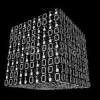I'm using HGEPP to handle the rendering of a 2D, top-down tile map.
To create a more organic feel, I decided to implement texture splatting.
When a tileset is allocated, it checks each tile for a property which determines if it can be splatted against other tiles.
Once an array of "splattable" tile graphics has been made, I create new tiles which implement transistions in each and all directions for each other "splattable" graphic.
This is incredibly time consuming, and was wondering if it would be possible to move this functionality into a DX9-compatible pixel shader.
Just as a quick example, I'm trying to do the following:
 +
+  +
+  =
= 
With the third image as an alpha map, how could this be implemented in a DX9-compatible pixel shader to "blend" between the first two images, creating an effect similar to the fourth image?
Furthermore, how could this newly created texture be given back to the CPU, where it could be placed back inside the original array of textures?




